Removing a Stuck VHS tape
If your video tape gets jammed inside your VCR, please take a moment to relax, breathe and think about your options. Your first impulse is to get out your ViseGrips and pull out the tape --- don't do it !!! At TGrant Photo we get many VCR's in for repair that have broken mechanisms, just because the owner couldn't wait to get their tape out! There are many expensive plastic parts in the loading mechanism of VCR's that are easily broken when you try to pry a videocassette out.
Scroll to the bottom of the page to see how to remove a jammed tape from other model VCRs
Removing a jammed VHS tape from a Panasonic AG-1980
The Panasonic AG-1980 usually protects itself when a tape hangs up inside. It will try to thread and if threading fails, it unthreads and ejects. If a tape fails to take-up properly during playback, the AG-1980 also unthreads and ejects. It's a very sophisticated machine. So if you have a tape that's jammed and won't eject, a problem with the mechanism or control circuitry is indicated. You'll probably have to have the unit serviced, but first you'll probably want to remove your tape.
Looking at the Panasonic AG-1980, you'd think that you could remove the top cover, take off the plate covering the cassette holder and pull the tape out. However that's the easiest way to damage the mechanism and twist the plastic loading gears out of alignment! Surprisingly, the safest way to remove a jammed tape is to manually actuate the loading mechanism from below and let the machine eject the tape.
First, remove the bottom metal plate of the VCR.
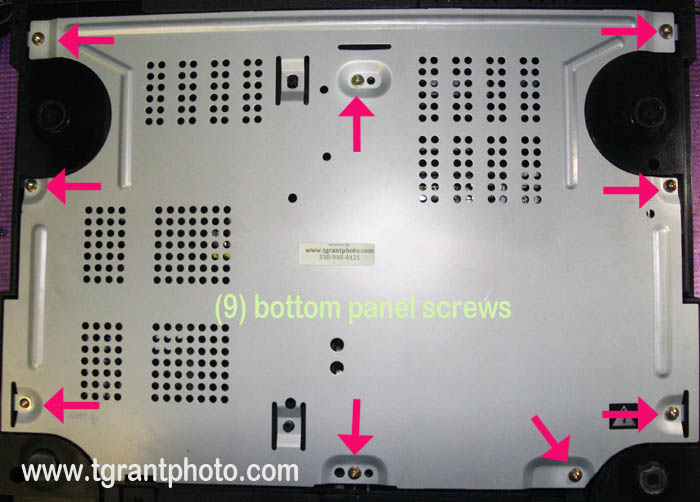
Below is what you'll see after the bottom is removed. Note the location of the thread/load motor.
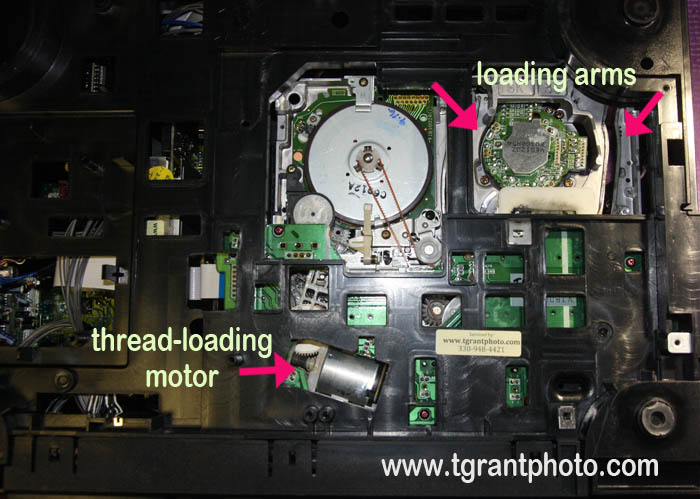
The thread/load motor has a small worm gear that drives the white plastic mechanism gear.
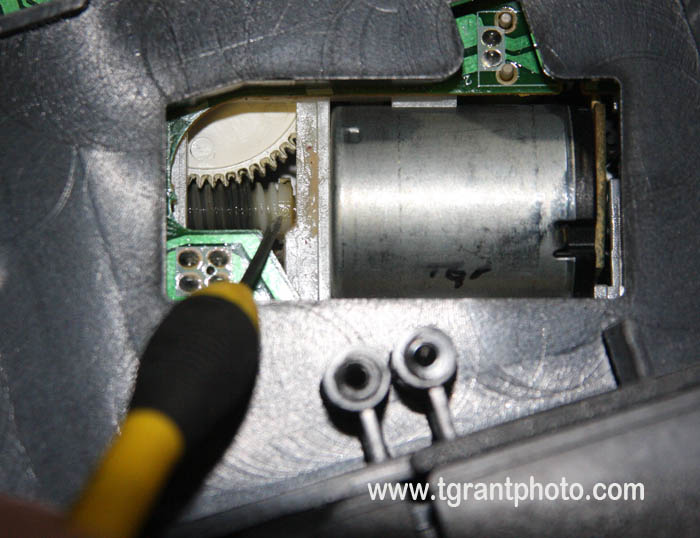
Use a small jeweler's type screwdriver (1/16" wide tip) to rotate the shaft of the motor. Use the screwdriver on the part of the shaft closest to the motor body. Rotate the shaft without touching the white worm gear, which can be damaged if you're too aggressive with it.
Keep rotating the shaft while looking at the white gear. To unload a tape, the white gear should rotate in the direction of the red arrow (see photo below)
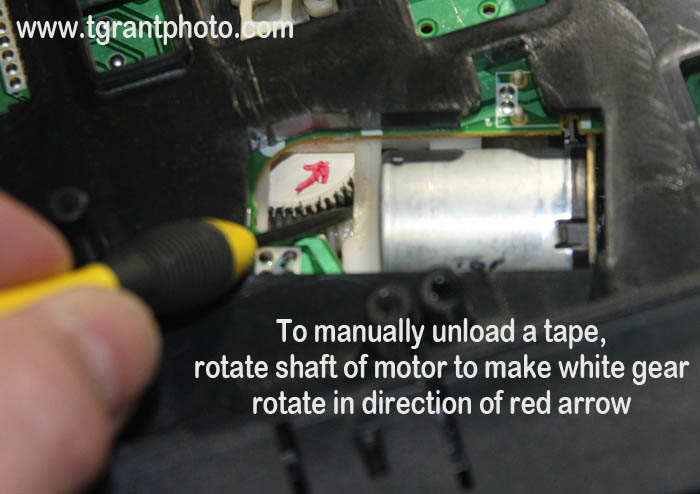
You'll be turning the motor shaft many times, 50-70 rotations. As you're doing this, turn your attention to the loading arms (see photos below) As the motor shaft turns you'll see the loading arms start to retract.
TIP - As the tape slowly unloads, you'll notice that the tape isn't being drawn into the cassette. Manually turn the 3" dia. flywheel counterclockwise, this will take up the slack tape and pull it into the cassette. (The flywheel is grey, 3" diameter and is visible on the underside of the mechanism).
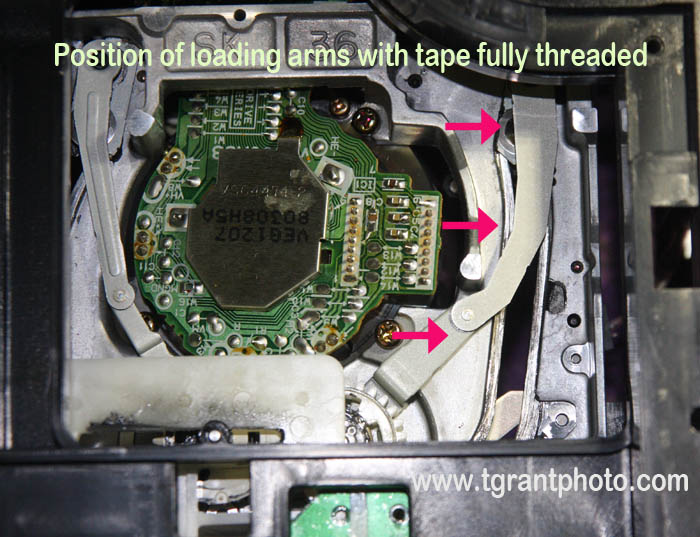
When the tape is unthreaded, the loading arms will be all the way at the bottom of the slot (see below)
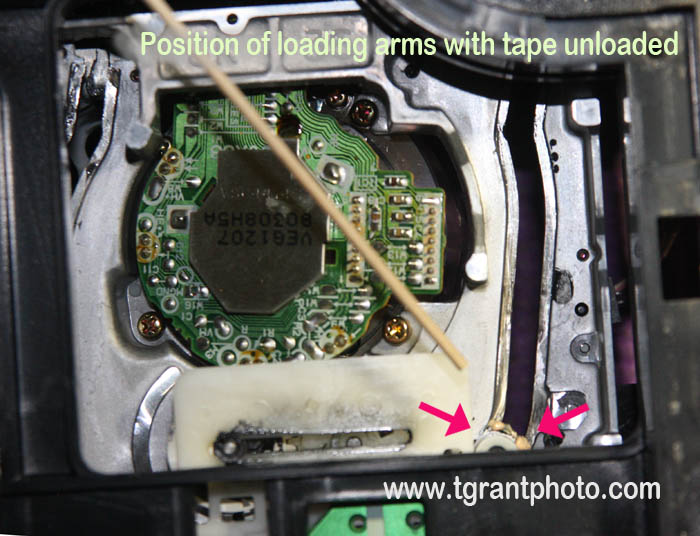
After many, many rotations of the motor shaft, you'll hear a rewarding 'click' as the tape ejects.
Important: Now that the tape is removed, please don't try to re-load it! There's always a cause for the tape not ejecting, and it's usually related to a failed mechanism part or a problem with the electronic control circuits.
Please feel free to give us a call, we'll be happy to give you an estimate on repairing your VCR. We can also remove your jammed videocassette while minimizing damage to the tape.
Remember, if you force parts or break the threading gears inside your VCR, repairs can be expensive, so please be careful!You're always welcome to call Tom at TGrant Photo if you have questions!
Removing a jammed VHS tape from generic VCR models
This applies to many consumer type VCRs that were sold in department stores.
You have two options:
1. Carefully remove the VCR cover and look for the tape loading motor. It's about 1" dia. by about 2" long. Many times it has a small black rubber belt coming off it. Find this motor, and, with the 120vac power unplugged, carefully rotate the motor with your finger to eject the tape. Try not to touch the surface of the video tape. The tape should slowly be ejected. You may have to manually wind the tape back into the cassette. Note: On some VCRs, such as the Panasonic AG-1980, the tape loading motor is a sealed unit below the mechanism. Tape removal on these units is very complicated and often involves disassembly of the entire mechanism.
2. In more extreme cases, the tape might be wrapped around the head drum. This is especially prevalent when you clean the head drum with alcohol and "can't wait" to play a tape. The tape sticks to the wet video head drum and wraps around it. In this case, you might have to cut the tape. Video tape can be spliced using a special tape, however this splice can sometimes damage the video heads when it's played back.
Remember, if you force parts or break the threading gears inside your VCR, repairs might exceed $100, so please be careful!
You're always welcome to call Tom at TGrant Photo if you have questions!
Note: The above content is copyright TGPSales & TGrant Photo. Copying or use on another website is prohibited.
